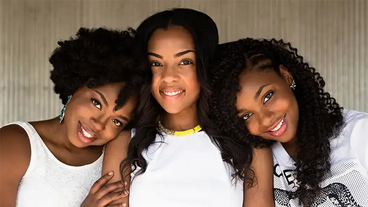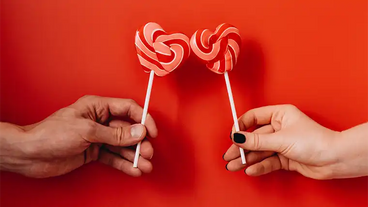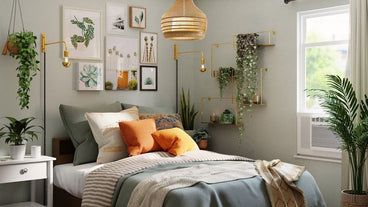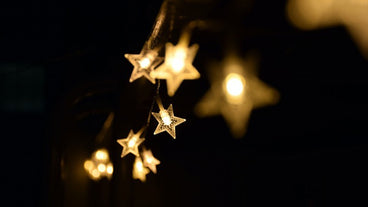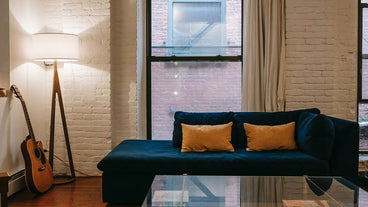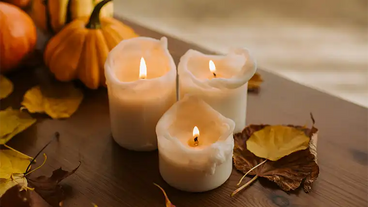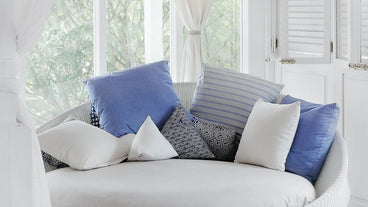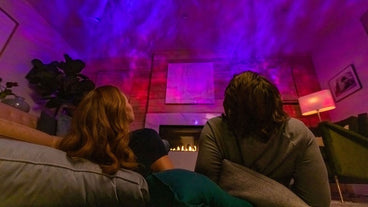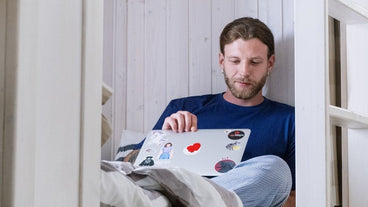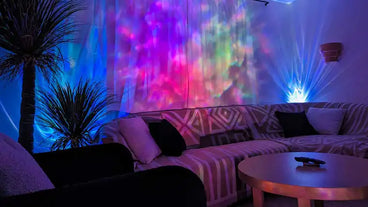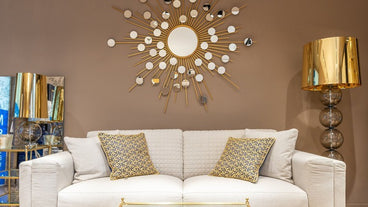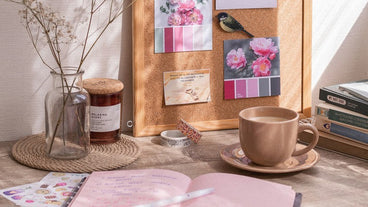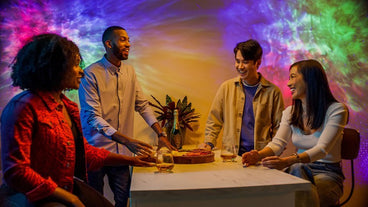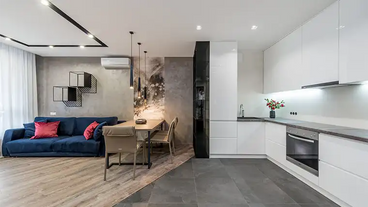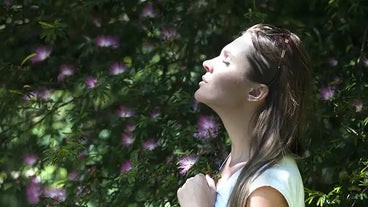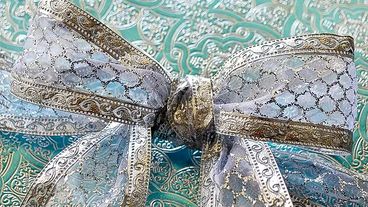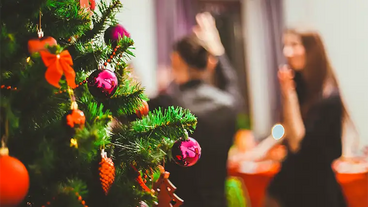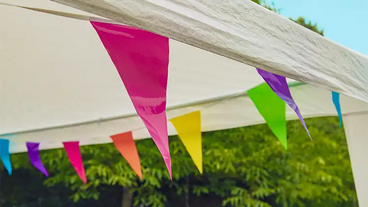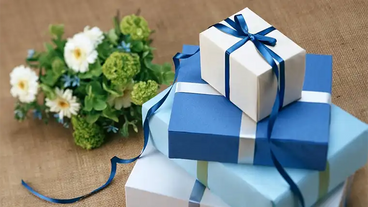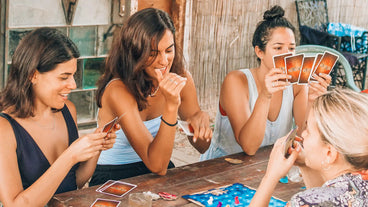Your bedroom is your personal sanctuary—why not decorate it like one? Bedroom colors can help set the right mood, allowing you to relax and unwind for a good night’s sleep, create a sense of tranquility, or even give you a jolt of energy. There’s a bedroom color and mood pairing out there for whatever you need—read on to learn more.
Why are bedroom colors important?
Bedroom colors matters because they can do the following:
- Helps ground you. You spend a lot of time in your bedroom—sleeping, slowly starting your day, choosing outfits. You’ll thus want it to be a place where you can feel grounded instead of energized. The color of your bedroom walls and lights can have a marked impact on your mood and energy levels, as we’ll explain in more detail later.
- Give energy. If you’ve ever walked into a room with unusual paint colors on the walls and felt a jolt of surprise, you know how room colors can give energy. Bright colors can make a room feel more stimulating, whereas dark colors can evoke a sense of tranquility.
- Create a positive space. A key tenet of color psychology is that certain hues, particularly yellows and golden colors, can lead to positive thoughts. Of course, color psychology states that some colors can have exactly the opposite effect, so choose wisely!
- Enable creativity. Color psychology also suggests that certain hues may stimulate the brain in ways that foster creativity. These hues are often bright and unusual – just like some of the best creative works.
- Make a space feel warm. When we say warm, we don’t mean hot – we’re talking not about heat temperature but color temperature. In other words, when a space looks warm, it’s inviting, relaxing, and perhaps even a bit elegant. Light of lower numerical color temperature values is warmer, and the wall paint color you choose for your indoor space can also impact its warmth.
How to choose the right color for your bedroom
When you’re trying to figure out which colors will work best in your room, you may find it easiest to come up with an answer if you ask yourself a handful of questions first. These include:
- Are you more alert at night or in the morning? If you’re a night owl, you may prefer bedroom colors that can stimulate you after sundown, when there’s no natural light to energize you. If you’re a morning person, you’ll probably be ready to go no matter the colors surrounding you when you wake up.
- Do you get out of bed immediately, or is the snooze button your best friend? In the former case, your bedroom color choices might have little impact on your energy levels. In the latter case, bright colors – which are known to be stimulating – might help you wean off the snooze button if you so desire.
- Do you fall asleep immediately, or does it take some time? If you struggle with insomnia, whether as you try to fall asleep or in the middle of the night, certain wall colors can help. Scientific studies have correlated these colors with calmness and/or easier sleep.
- Do you let in the light upon waking up or wait a while to throw open the blinds? Craving light the moment you’re awake might suggest a need for brighter walls. With bedroom colors that already glow just fine without any boost from artificial lighting, you’ll be less likely to need that extra rapid burst of natural light.
- Do white or bright colors tire you? The fluorescent white lighting common in offices and hospitals is known to make people feel more tired1. If this notion immediately makes sense to you, perhaps you’re realizing that white or bright colors tire you. If your bedroom includes not just your bed but your desk, you may thus prefer non-white colors. Alternatively, you could move your desk to a room with more energizing colors.
- Are you a minimalist or do you like lots of decor? The fewer decorations you have in your bedroom, the larger the impact of your bedroom’s color on its mood. With every decoration you add, you cover a greater portion of your walls and thus reduce your bedroom colors’ impacts. Additionally, the colors of your decorations can complement or grate against your base color, leading to additional mood effects.

Bedroom colors and mood
Below are several common bedroom colors for which color psychology or additional scientific research have established potential effects on your mood and sleep:
1. White
White color schemes can feel fresh, crisp, and clean2. They can also make your room appear more spacious. However, as mentioned earlier, overly bright white fluorescent lights can have negative mood impacts. Lighter shades of white can instead impart the space-expanding, cooling effects that interior designers love – most interior walls are white for a reason.

2. Yellow
Yellow rooms can be cheery and energizing3, and bright yellow walls are especially stimulating. Yellow requires care to use successfully indoors – overly bright hues can prove overstimulating or even angering for many people. Duller yellows, though, can provide a gently uplifting feeling great for living rooms.

3. Purple
Purple is often associated with matters of the mind and heart4. Deep purple colors often feel sad, perhaps making them inappropriate for interior design, whereas light purple hues can be light-hearted and even romantic. The whimsical nature of lighter purple shades can also foment creativity, making them great for workspaces.

4. Orange
Orange is a mix of reds and yellows5, and this distinction is important when figuring out how to use it for your interior design. Darker orange shades may impart the calming effects associated with red, whereas brighter orange colors might as well be intense yellow hues. As such, dark orange may work well in bedrooms or living rooms, but bright orange may be best left out of the equation.

5. Black
Technically, black isn’t a color – instead, it’s how we perceive the absorption of all colors. That’s why black can be so dramatic or gloomy, and it’s also why black can be so bland and dreadful.
Of course, black is associated with death, but since it’s also the leading color for men’s formalwear, it may connote elegance to some6. This latter connotation guides the use of black in interior design – for example, a black accent wall in your living room can appear classy and welcoming. That said, a room of entirely black walls might feel a bit claustrophobic – black is best used sparingly.

6. Pink
In the 2014 book Drunk Tank Pink, author Adam Alter recounts a series of 1980s experiments on using pink light to calm aggressive prisoners. Drunk Tank Pink also explores the use of pink colors beyond prisons – buses with pink seats, for example, were vandalized less frequently. Alter also explores how charities’ donations increased after they began spreading pink promotional materials7. You can bring that same calming effect into your home with pink walls.

7. Gray
Scientifically, gray is a mixture of black and white8, and it’s considered a neutral color. As such, gray’s mood effects are especially dependent on the other colors you use in your room. A space of primarily gray and black hues might feel dreadful and moribund, whereas a space that balances gray and white can appear as elegant as the aforementioned black contrast wall. In some spaces, gray can even feel stabilizing or calming.

8. Brown
Soft, light brown colors can be comforting and romantic9. Try them in your dining room for a soothing, savory meal, or add them to your living room for an oaky, natural feel that evokes the tranquility of the forest. Just be careful not to go overboard with brown – in large amounts, brown can evoke negative emotions such as sadness and emptiness.

9. Red
According to one hypothesis, red light may have calming properties since the human eye isn’t very sensitive to high-wavelength light colors10. The U.S. Centers for Disease Control and Prevention (CDC) has endorsed this theory, which may partially explain why alarm clocks so often have red numbers – other colors could keep you awake at night11.
To experience the potential calming effects of red light wherever you go, bring a StarPort Laser USB on the road. No matter where you are, you can plug your StarPort into a wall charger or mobile charger for an instant view of red starry skies. Try counting the stars to calm your mind – or just let the red hues work their relaxing magic.


10. Green
Green light, according to a 2016 University of Oxford study, can promote sleep and thus the myriad mood-improving effects that accompany proper sleep12. The study’s authors found that green light may interact with the sleep hormone melanopsin13 (not to be confused with the far better-known melatonin), thus leading to quicker sleep onset.
Additionally, a 2009 Canadian Medical Association Journal survey of green light use in hospitals correlated green light with calmness14. This survey found that hospital green light helped to soothe patients, many of whom were understandably anxious given the medical issues they faced.
An especially soothing form of green light is the auroras that the Ark Ambient Aurora Light emits. These green auroras oscillate gently and soothingly, transforming your bedroom into a comfortable space perfect for relaxation, sleep, or both. You’ll enjoy the magic and placidity of a green sky without ever going anywhere to see it.


11. Blue
According to a 2017 PLOS ONE study, those experiencing stress can relax up to three times more quickly in blue lighting than in everyday white lighting15. Blue light might thus be just what you need to make your bedroom an especially calming place. And since it’s where you go to sleep, taking it easy there only makes sense.
For an especially transportive blue light experience, give the Sky Lite Evolve Galaxy Projector a try. With just the push of a button, you can flood your room with multicolor nebula clouds and twinkling stars that set a transfixing, soothing mood. No longer will you have to roll around in bed to find that perfectly calming sleep position – BlissLights effortlessly take you there.
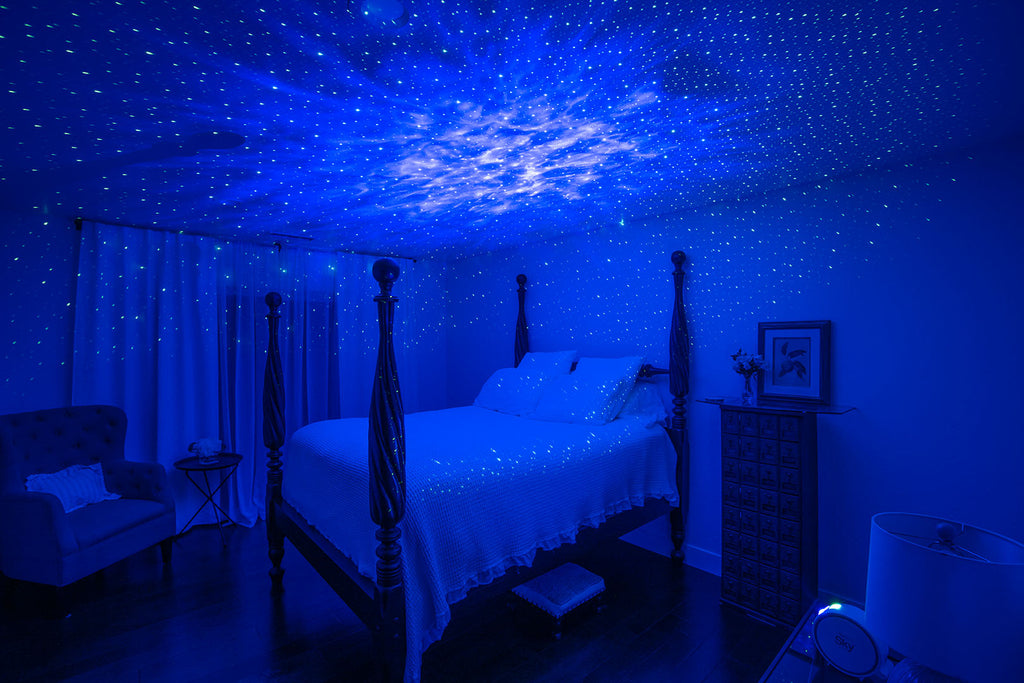

Sky Lite Evolve: Smart Galaxy Projector
$49.99$39.99
The latest evolution in smart galaxy lighting.
Get the right bedroom colors and moods with BlissLights
The color of your bedroom can substantially alter how it feels. Yellow and orange hues can prove overly stimulating and thus be imperfect for turning your brain off for sleep, whereas blue, green, and red can all have the opposite effect. Here at BlissLights, all our laser lights are red, blue, or green, so browse our collection for the calming bedroom of your literal and figurative dreams. Our lights can transport you to sleep, creativity, or somewhere far beyond either.
Citations
You may also enjoy these...
Discover fun and unique lighting ideas on the BlissLights Lighting Blog!


